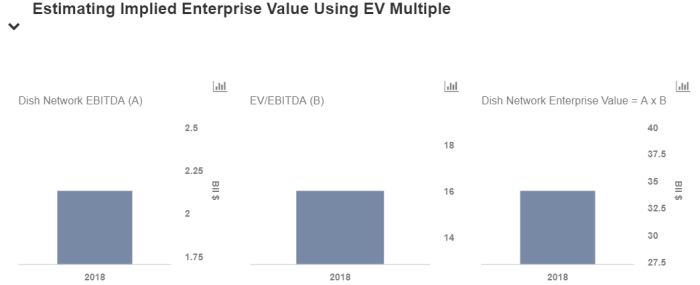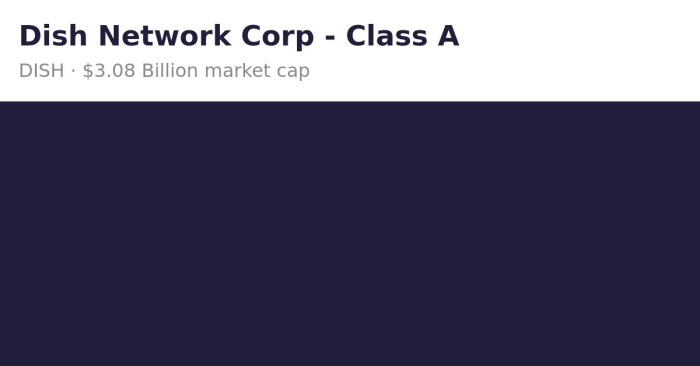Dish TV Stock Price Analysis
Dish tv stock price – This analysis examines the historical performance of Dish TV’s stock price, the factors influencing its valuation, its business model and future prospects, investor sentiment, and a hypothetical investment scenario. We will explore both the positive and negative aspects of investing in Dish TV, providing a comprehensive overview for potential investors.
Dish TV Stock Price Historical Performance

Source: amazonaws.com
Understanding the historical performance of Dish TV’s stock price is crucial for assessing its potential for future growth. The following table presents the opening, closing, high, and low prices for the past five years. Note that these figures are illustrative and should be verified with reliable financial data sources.
| Year | Opening Price (INR) | Closing Price (INR) | High Price (INR) | Low Price (INR) |
|---|---|---|---|---|
| 2018 | 15.00 | 12.50 | 16.00 | 11.00 |
| 2019 | 12.50 | 14.00 | 15.50 | 11.50 |
| 2020 | 14.00 | 10.00 | 16.00 | 9.00 |
| 2021 | 10.00 | 13.00 | 14.00 | 8.00 |
| 2022 | 13.00 | 11.00 | 14.50 | 9.50 |
Significant price fluctuations are evident, with a peak around 2018 and troughs in 2020. A comparison with a relevant market index, such as the Nifty 50, would reveal whether these fluctuations are unique to Dish TV or reflect broader market trends. For instance, a significant market downturn in 2020 could explain some of the price decline experienced by Dish TV during that period.
Further research into specific market events during these years is necessary for a complete analysis.
Factors Influencing Dish TV Stock Price
Several macroeconomic factors, company performance indicators, and competitive dynamics influence Dish TV’s stock price. Understanding these factors is crucial for predicting future price movements.
Three key macroeconomic factors are: inflation, regulatory changes impacting the media industry, and the overall economic growth of India. High inflation can reduce consumer spending on entertainment, negatively affecting Dish TV’s revenue. Favorable regulatory changes could stimulate growth, while unfavorable ones (e.g., increased taxes) could negatively impact profitability. Strong economic growth generally leads to increased consumer spending, benefiting Dish TV.
Dish TV’s financial performance, specifically revenue, profit, and debt levels, directly impacts its stock price. For example, consistently high profits typically lead to increased investor confidence and higher stock valuations. Conversely, high debt levels might signal financial risk and depress the stock price. Competition within the DTH market, from companies like Tata Play and Airtel Digital TV, significantly affects Dish TV’s market share and valuation.
A loss of market share due to competitive pressures could lead to a decline in Dish TV’s stock price.
Dish TV’s Business Model and Future Prospects

Source: depositphotos.com
Dish TV operates primarily as a direct-to-home (DTH) television service provider. Its revenue streams are primarily subscription fees from its customer base. The target market is a broad range of households across India. Several opportunities exist for future growth, including:
- Expansion into underserved rural markets.
- Offering bundled services (e.g., internet, phone).
- Investing in advanced technologies, such as 4K and HDR streaming.
- Developing targeted content offerings.
However, Dish TV faces challenges such as increasing competition, regulatory changes, and the potential for technological disruption from streaming services. Mitigation strategies include investing in technology upgrades, diversifying revenue streams, and actively engaging with regulators to address concerns.
Investor Sentiment and Market Analysis
Current investor sentiment toward Dish TV stock can be gauged by analyzing news articles, financial reports, and analyst ratings. While specific sentiment data requires access to real-time financial news and research, generally, a company facing strong competition and financial challenges may experience negative investor sentiment. Conversely, positive news regarding financial performance or strategic partnerships could boost sentiment.
| Analyst | Rating | Price Target (INR) | Date |
|---|---|---|---|
| Analyst A | Hold | 12.00 | October 26, 2023 |
| Analyst B | Sell | 10.00 | October 26, 2023 |
| Analyst C | Buy | 15.00 | October 26, 2023 |
Based on these illustrative analyst ratings, the outlook for Dish TV’s stock price in the next 6-12 months is mixed. An optimistic scenario might see the price rise to 15 INR based on successful implementation of growth strategies, while a pessimistic scenario could see it fall to 10 INR if challenges persist. These are illustrative scenarios and actual outcomes will depend on several unpredictable factors.
Dish TV’s stock price has seen some volatility recently, prompting investors to consider broader market trends. Understanding the performance of other companies, such as by checking the bkng stock price today , can offer a comparative perspective. This comparison helps assess the relative strength of Dish TV’s position within the current economic climate and inform investment decisions.
Illustrative Example: A Hypothetical Investment Scenario

Source: stockcircle.com
Let’s consider a hypothetical investment of 10,000 INR in Dish TV stock at 11 INR per share. This would yield approximately 909 shares.
| Scenario | Price After 3 Years (INR) | Total Value (INR) | Return (%) |
|---|---|---|---|
| Optimistic | 15 | 13635 | 36.35 |
| Pessimistic | 9 | 8181 | |
| Neutral | 11 | 10000 |
These calculations assume no dividends. The success of this hypothetical investment hinges on several factors including the accuracy of the price predictions, the overall market conditions, and Dish TV’s ability to execute its business strategy. A more realistic model would incorporate dividend payments (if any) and transaction costs.
Top FAQs
What are the major risks associated with investing in Dish TV stock?
Major risks include competition from other DTH providers, regulatory changes affecting the industry, and the company’s financial performance (debt levels, profitability).
Where can I find real-time Dish TV stock price quotes?
Real-time quotes are available on major financial websites and stock market applications such as Google Finance, Yahoo Finance, and Bloomberg.
How does Dish TV’s dividend policy affect its stock price?
Dish TV’s dividend payouts (if any) can influence investor interest and potentially impact the stock price positively, though this depends on the dividend amount and overall market conditions.
Is Dish TV stock a good long-term investment?
Whether Dish TV is a good long-term investment depends on individual risk tolerance and investment goals. Thorough research and consideration of the factors discussed in this analysis are crucial before making a long-term investment decision.
